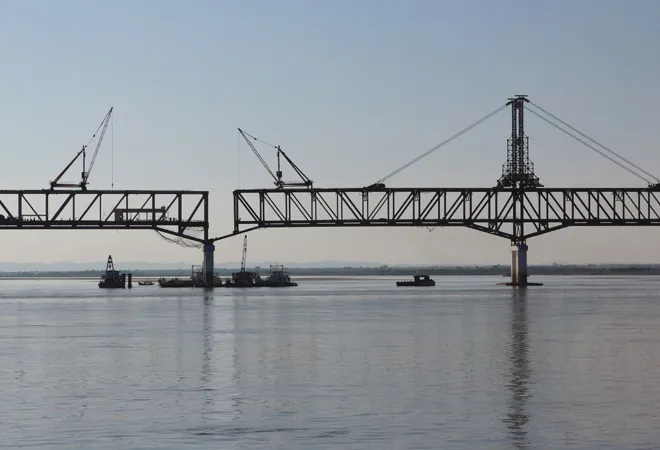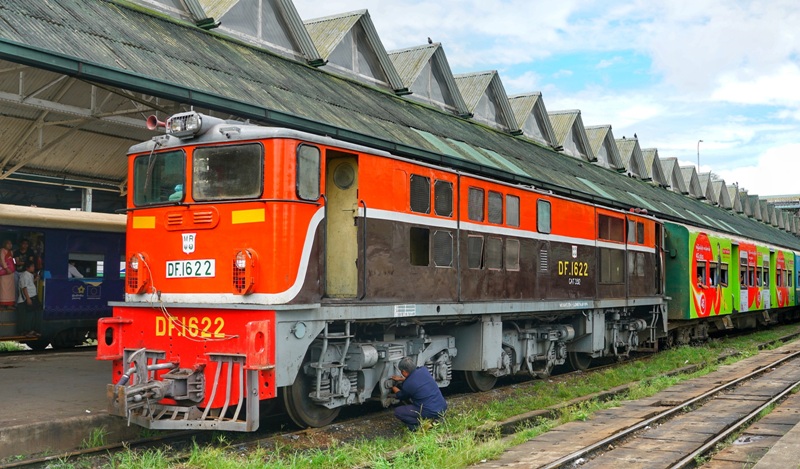 This is the sixty second part in the series
This is the sixty second part in the series The China Chronicles.
Read all the articles here.
Myanmar’s diplomatic balancing is under stress in the face of the West distancing from Naypyidaw over the country’s handling of the Rohingya crisis. As in the past, Naypyidaw is tilting towards its northern neighbour for both political and economic support and Beijing is fully leveraging the situation to its advantage, but it will be a bumpy road.
After years of close strategic relations during Myanmar’s military rule, China-Myanmar relations plunged into a phase of uncertainty when Myanmar military regime decided to take the path of democratisation in 2010. In the following years, Myanmar’s suspension of two China-funded projects — the Myitsone hydropower project in 2011 and the Letpedaung coppermine in 2013 — marked the beginning of a troubled relationship.
Beijing recalibrated its policy towards Myanmar to suit the changing times with the aim to arrest growing anti-Chinese sentiments in the Southeast Asian nation and to safeguard its core strategic interests including limiting strategic ties between Naypyidaw and Washington.
When the Aung San Suu Kyi-led National League for Democracy (NLD) government took office in 2016, contrary to popular perceptions, it adopted a balanced policy towards China and the West. Beijing’s Myanmar policy revision may have paid off, but it was Naypyidaw’s conscious strategic balancing that allowed the diplomatic equilibrium to evolve.
Myanmar’s suspension of two China-funded projects — the Myitsone hydropower project in 2011 and the Letpedaung coppermine in 2013 — marked the beginning of a troubled relationship.
The China-Myanmar Economic Corridor
Myanmar joined the Chinese Belt and Road Initiative (BRI) when State Counsellor Suu Kyi attended the Belt and Road Forum for International Cooperation in Beijing in May 2017. A MoU on “Cooperation within the Framework of the Silk Road Economic Belt and 21st Century Maritime Silk Road Initiative” was signed during the visit.
Under the BRI scheme, two economic corridors — the Bangladesh-China-India-Myanmar-Economic Corridor (BCIM-EC) and the China-Indochina-Peninsula Economic Corridor (CIPEC) involve Myanmar, owing to its geographic location. Both Beijing and Naypyidaw recognise Myanmar’s critical role in pushing forward these BRI projects.
Beijing proposed the China-Myanmar-Economic Economic (CMEC) as part of the BRI at a time when Myanmar was increasingly under international pressure owing to its conduct on the Rohingya crisis. Beijing is aware that Myanmar needs its political and diplomatic support to fend-off mounting international scrutiny.
As Beijing’s relations with Naypyidaw entered a difficult phase in the reform period, China began to push alternative corridors including the China-Pakistan Economic Corridor (CPEC), the China-Laos-Thailand (CLT) road and railway corridors and, in recent years, the China-India-Nepal corridor under the BRI scheme. With Naypyidaw now more receptive to Chinese initiatives, Beijing is likely to prioritise the CMCE as it remains the shortest route for China to reach the Indian Ocean and beyond.
As part of the CMEC, major roads and railways are being proposed to link China’s Yunnan province with Myanmar’s major cities.
Last week, a report
citing a Myanmar official said that China and Myanmar have reached a “15-point MoU” on the CMPC. The corridor will run from Chinese Yunnan province to Mandalay in central Myanmar and then south to Yangon and west to Kyaukpyu SEZ forming a “Y-shape” corridor involving basic infrastructure, construction, manufacturing, agriculture, transport, finance, human resources development, telecommunications, and research and technology to develop the CMEC, the report added.
As part of the CMEC, major roads and railways are being proposed to link China’s Yunnan province with Myanmar’s major cities. In March 2018, the two countries signed a MoU to conduct a feasibility study for construction of two major corridors — the Mandalay-Tigyaing-Muse expressway project and the Kyaukpyu-Naypyidaw highway project. Nonetheless, not everything may go the way Beijing would like it to be. Growing wariness about China’s mega-projects is at an all-time high in Myanmar.
The Kyaukpyu Deep-Sea Port
The latest in a series of Chinese mega-projects in Myanmar that have been drawn into debate is the strategic Kyaukpyu SEZ in Rakhine State of Myanmar. The USD 10 billion project involving developing a new deep-sea port (USD 7.5 billion) and an industrial park (USD 2.5 billion) was awarded to a consortium led by Chinese state investment company, CITIC Group in 2015.
Last week,
Myanmar’s planning and finance minister, Soe Win said Myanmar would ask China to reduce to scale of the project. The minister gave an economic argument for the need to downsize the China-led Kyaukpyu SEZ project saying that “the bigger the projects, the bigger the responsibility to pay back.”
A couple of months earlier,
Sean Turnell, a senior economic consultant to Suu Kyi expressed similar concerns about the project saying that the USD 7.5 billion price tag for the deep-sea port was “way, way, way beyond what
needs.” According to Turnell, the Myanmar government has “really taken notice” of Sri Lankan experience where Colombo had to give Chinese companies a 99-year lease for the USD 1 billion Hambantota port in southeast of the Island nation as it was unable to repay debt it heavily borrowed from China for the construction of the port.
Some in Myanmar’s policy circles play down the debt fear. Last month, while attending the 3rd Belt and Road Summit held in Hong Kong, Myanmar’s Union Minister for the Ministry of the Office of the Union Government and the Chairman of Myanmar’ Investment Commission Thaung Tun, dismissed the fear of a ‘debt trap’. Nonetheless, Tun said Myanmar was aware of “what happened” in Sri Lanka and Naypyidaw would “make sure” the Kyaukpyu port is “a workable project”, suggesting that Myanmar is not ruling out downsizing the project.
Myanmar renegotiated a previous 85/15 per cent shareholder agreement that was widely viewed as “unfair” in October 2017. Under the new deal, CITIC group would take 70 per cent stake while the rest split between the Myanmar government and a consortium of local firms.
Initial reports over the prolonged negotiations on the Kyaukpyu SEZ project suggested that Naypyidaw was unconvinced about the commercial viability of the project. This may be valid as Kyaukpyu, being far from the country’s biggest city Yangon may not be able to generate rapid logistics demand.
Myanmar renegotiated a previous 85/15 per cent shareholder agreement that was widely viewed as “unfair” in October 2017. Under the new deal, CITIC group would take 70 per cent stake while the rest split between the Myanmar government and a consortium of local firms. Even so, concerns is shifting to the scale of the project. The key issue that seem to worry Naypyidaw most is the experiences from neighbouring countries.
The Kyaukpyu-Kunming Railway
That is not all, in 2014, the strategic rail project planned to link China’s inland province of Yunnan to the Indian Ocean from Kyaukpyu to Kunming was allowed to expire when the deal signed between China Railway Engineering Corporation (CREC) and Myanmar Railway Ministry failed to commence construction within the three-year stipulated timeframe agreed under the deal. Recent reports suggest that Myanmar’s concerns over “social opposition, financial feasibility, distribution of gains and national security” were key reasons for halting the railway project.
 For Beijing, the Kyaukpyu project is a key component of the BRI. Except for the oil and gas pipelines linking the Bay of Bengal to China through Myanmar, most of the Chinese mega-projects in Myanmar hang in a limbo. This may not only create tensions in China-Myanmar relations, but also create hurdles for the development of China’s BRI projects through Myanmar.
Concerns also remain about the implications of the troubled China-Myanmar borderlands on the mega-infrastructure projects under the BRI scheme. Myanmar’s efforts to find peace in the border regions remain elusive. Ahead of the third round of peace talks under the government’s 21st-Century Panglong Conference scheduled for 11 to 16 June 2018, Beijing has reassured Naypyidaw that it would continue to “keep helping and supporting” the country’s peace process.
For Beijing, the Kyaukpyu project is a key component of the BRI. Except for the oil and gas pipelines linking the Bay of Bengal to China through Myanmar, most of the Chinese mega-projects in Myanmar hang in a limbo. This may not only create tensions in China-Myanmar relations, but also create hurdles for the development of China’s BRI projects through Myanmar.
Concerns also remain about the implications of the troubled China-Myanmar borderlands on the mega-infrastructure projects under the BRI scheme. Myanmar’s efforts to find peace in the border regions remain elusive. Ahead of the third round of peace talks under the government’s 21st-Century Panglong Conference scheduled for 11 to 16 June 2018, Beijing has reassured Naypyidaw that it would continue to “keep helping and supporting” the country’s peace process.
Except for the oil and gas pipelines linking the Bay of Bengal to China through Myanmar, most of the Chinese mega-projects in Myanmar hang in a limbo. This may not only create tensions in China-Myanmar relations, but also create hurdles for the development of China’s BRI projects through Myanmar.
With new projects proposed under the BRI scheme, Myanmar’s concerns over security implications and financing issues will only grow owing to its own experience and lessons it is learning from neighbouring countries is increasingly shaping public opinion in Myanmar. Naypyidaw may seek alternative options to reduce dependence on Chinese investment. However, for now, with its internal conflicts in the borderlands and the need to ward off international pressures, Naypyidaw may go along with Beijing’s initiatives. This would be accompanied by growing concerns and more questions on whether Naypyidaw’s only option is to accept Chinese initiatives without having any initiative of its own.
Myanmar’s desire to minimise Beijing’s overbearing influence is often neutralised by the interlinked political and security considerations at their shared borderlands and the need to seek diplomatic and economic support from China in the face of international pressures.
China’s long-term strategic interests of seeing Myanmar as a “land bridge” to reach the Indian Ocean will continue to drive Beijing’s strategy. This interdependency defining the relationship is unlikely to change in the near future.
However, China will face a dilemma sooner than later. In the short-term, Myanmar’s internal conflicts may suit Beijing’s interests as they create conditions for Naypyidaw to seek Beijing’s support and generate tension between the West and Myanmar. However, continued internal conflicts in Myanmar will affect border stability with huge implications for development of BRI projects and, on the other hand, may invite other major powers to involve themselves in these conflicts.
This will undermine Beijing’s key strategic interests in Myanmar — pushing the BRI through Myanmar and keeping other major powers in Myanmar at bay. Until that time, it is unlikely that Myanmar’s strategic value for China will undergo any drastic re-evaluation, despite the challenges.
The views expressed above belong to the author(s). ORF research and analyses now available on Telegram! Click here to access our curated content — blogs, longforms and interviews.



 This is the sixty second part in the series The China Chronicles.
Read all the articles
This is the sixty second part in the series The China Chronicles.
Read all the articles  For Beijing, the Kyaukpyu project is a key component of the BRI. Except for the oil and gas pipelines linking the Bay of Bengal to China through Myanmar, most of the Chinese mega-projects in Myanmar hang in a limbo. This may not only create tensions in China-Myanmar relations, but also create hurdles for the development of China’s BRI projects through Myanmar.
Concerns also remain about the implications of the troubled China-Myanmar borderlands on the mega-infrastructure projects under the BRI scheme. Myanmar’s efforts to find peace in the border regions remain elusive. Ahead of the third round of peace talks under the government’s 21st-Century Panglong Conference scheduled for 11 to 16 June 2018, Beijing has reassured Naypyidaw that it would continue to “
For Beijing, the Kyaukpyu project is a key component of the BRI. Except for the oil and gas pipelines linking the Bay of Bengal to China through Myanmar, most of the Chinese mega-projects in Myanmar hang in a limbo. This may not only create tensions in China-Myanmar relations, but also create hurdles for the development of China’s BRI projects through Myanmar.
Concerns also remain about the implications of the troubled China-Myanmar borderlands on the mega-infrastructure projects under the BRI scheme. Myanmar’s efforts to find peace in the border regions remain elusive. Ahead of the third round of peace talks under the government’s 21st-Century Panglong Conference scheduled for 11 to 16 June 2018, Beijing has reassured Naypyidaw that it would continue to “ PREV
PREV


